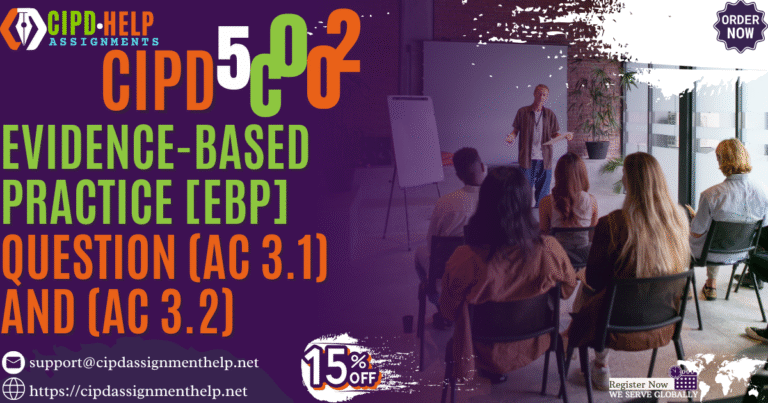5OS03 Learning and Development Essentials Assignment Help Comprehensive Outline
Assignment Brief 1: Understand how learning and development connects with other areas of the organisation.
Explore key themes and agendas that are currently shaping the provision of learning and development in organisations.
- Give a brief description of learning and development in organisations
- Key themes and agendas currently shaping the provision of learning and development in organisations
- Artificial intelligence
- Social learning and communities
- Skills
- Value and Return on Investment (ROI)
- How do these themes and agendas shape the provision of learning and development in organisations?
- Why is it important to understand these key themes and agendas currently shaping the provision of learning and development in organisations?
- What are the implications to people practice professionals in organisations?
Compare different ways learning and development connects with other areas of the organisation and supports the achievement of business goals and objectives.
- Different ways learning and development connects with other areas of the organisation and supports the achievement of business goals and objectives
- Analysis of training needs
- Creating a value-based culture
- Setting SMART goals
- Identification of skills gaps
- Evaluation: What are the differences based on;
- How do these ways connect with other areas of the organisation?
- How do these ways support the achievement of business goals and objectives?
- Why is it important to understand the connection of these ways with other areas of other organisation?
- What are the implications for people practice professionals in organisations?
Evaluate methods for identifying learning and development needs and requirements at different levels:
Organisation – Example of different levels of an organisation; Strategic level, Tactical level and Operational level
- Methods: Conducting learning needs analysis using;
- Organisational data and intelligence
- Formal interviews, focus group with stakeholders
- Documentation – for example; organisation wide business plans
- Team
- Team meetings
- Consult with team leaders
- Questionnaire of team representatives
- Individual
- Observations
- Existing data from a learning management system
- Informal conversations with stakeholders
- Evaluation
- How are these methods used to identifying learning and development needs and requirement at the different levels?
- Are these methods effective in identifying learning and development needs and requirement at the different levels?
- What are the implications for people practice professionals in organisations?
- Evaluation
Assignment Task 2: Understand the design of learning and development solutions.
Discuss how different learning methods can be blended to form engaging learning and development solutions.
- Give a brief description of learning and development solutions
- Name the various learning methods
- How to blend different learning methods to form learning and development solutions
- Flex model – combine physical learning (face-to-face) and digital learning (perform online learning activities)
- Rotational model – Blend physical office training and online sessions
- Enriched virtual model – Online learning but with face to face interactions
- What learning and development issues are solved by blending the different learning methods?
- What are the implications for people practice professionals in organisations?
Evaluate the concepts and strategies for supporting the transfer of learning to the workplace including consideration at initial design.
- Concepts for supporting the transfer of learning to the workplace
- Frame the training
- Provide continuous support
- Communicate to reinforce learning
- Strategies for supporting the transfer of learning to the workplace
- Consideration of the initial design
- Align with organisational goals
- Use simulations
- Evaluation
- How do these concepts and strategies support the transfer of learning to the workplace?
- Are they effective in transferring learning to the workplace?
- What are the implications for people practice professionals in the workplace?
Assess the importance of including evaluation and impact assessment at the design stage.
- Give a brief description of the design stage
- Evaluation assessment
- Give a brief description of evaluation assessment
- Importance of including evaluation assessment at the design stage
- To reflect, question and deliberate on improved learning
- Assess the effectiveness of the professional learning programs
- Obtain reliable information for decision-making for professional learning and development, and the effects of the change
- Impact Assessment
- Give a brief description of impact assessment
- Importance of including impact assessment at the design stage
- To establish the impact of the change (learning and development initiatives)
- Identify and mitigate any possible negative effects
- iii. Include more effective learning and development initiatives
- What are the implications for people practice professionals in organisations?
Learning Outcome3: Understand the importance of facilitating learning in different contexts.
Evaluate ways in which to facilitate learning in groups to enhance learner engagement.
- What does learning in groups entail?
- Give a brief description of learner engagement
- Ways of facilitating learning in groups to enhance learner engagement
- Promote active learning
- Include cooperative learning
- Gamification
- Evaluation
- Are these ways effective in facilitating learning in groups?
- How do they facilitate learning in groups?
- To what extend do these ways enhance learner engagement?
- What are the implications for people practice professionals in the organisation?
Evaluate how online facilitation differs from face-to-face facilitation for facilitators and learners.
- Online facilitation
- Give a brief description of online facilitation for facilitators and learners
- How does it happen?
- What are the benefits?
- What are the challenges?
- Face-to-face facilitation
- Give a brief description of face-to-face facilitation for facilitators and learners
- How does it happen?
- What are the benefits?
- What are the challenges?
- Evaluation
- What are the differences between online facilitation and face-to-face facilitation for facilitators and learners?
- Why is it important to understand these differences?
- What are the implications for people practice professionals?
Assignment Brief 4: Understand the importance of alternative methods of learning for individuals and organisations.
Evaluate the potential benefits and risks of informal and self-directed learning for individuals and organisations.
- Informal learning for individuals and organisations
- Give a brief description of informal learning
- Potential benefits of informal learning for individuals and organisations
- Increased engagement
- Time and cost saving
- Reduced stress
- Potential risks for informal learning for individuals and organisations
- Dependence on self-motivation
- Limited scope
- Inconsistency in training
- Self-directed learning for individuals and organisations
- Give a brief description of self-directed learning
- Potential benefits of self-directed learning for individuals and organisations
- Flexibility – learning at own pace and needs
- Independence from external resources
- Motivation for greater productivity and performance
- Potential risks for self-directed learning for individuals and organisations
- Too much choice that can be overwhelming to individuals
- Individuals will learn only what interests them
- Organisations may ignore learning opportunities
- Organisations may get lost in the content thus getting frustrated
Assess the steps that learning professionals can take to encourage informal learning in organisations and to support individuals to manage their own learning.
- Steps learning professionals can take to encouraging informal learning in organisations
- Provide opportunities
- Create a learning culture
- Establish programs
- Steps learning professionals can take to support individuals to manage their own learning
- Involve them in learning
- Encourage self-directed learning
- Support transfer of learning
- Evaluation
- Are these steps effective to encourage informal learning in organisations?
- Are these steps effective to support individuals to manage their own learning?
- What are the implications for people practice professionals in organisations?





